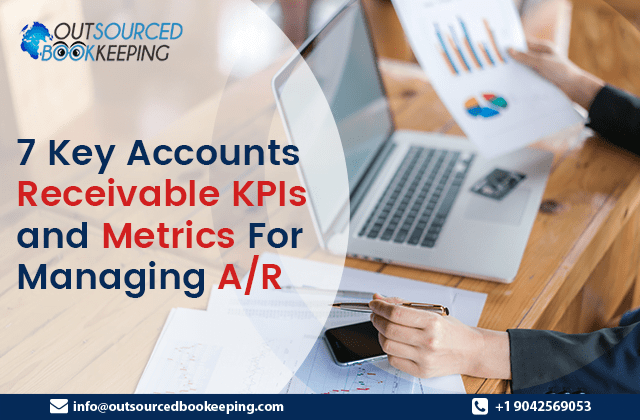KPIs and Metrics are real-time scorecards that give you visibility over the progress and assessment of performance. Tracking the right KPIs helps you know your current status and enables you to steer your ship towards the right destination. The more complex & comprehensive the process higher is the need for identifying and tracking the right KPIs. And in accounting, what could be more difficult and vital than Accounts Receivable?

Accounts Receivable – Need for Metrics & KPIs:
The information stuck in soloed legacy systems, disorganized processes, manual operations, and inconsistent collection process makes AR vague. The need for more visibility and control is akin to staying in the dark about your cash collection process.
One needs to have real-time visibility over the AR performance to identify the issues and make necessary adjustments according to cash flow requirements. And the only way to make that happen is to have an AR dashboard with the right metrics and KPIs that provide a quick overview of the AR performance and the right insights to correct the course.
A strong Accounts Receivable dashboard with the right KPIs and metrics is an indispensable tool that can help you in this process. But what are the relevant AR KPIS and metrics? Let us find out in this blog here.
The Only Seven Key Accounts Receivable KPIs You Need to Track:
Days Sales Outstanding (DSO): Days Sales Outstanding is the average number of days a business takes to collect customer payment. It says how quickly your AR is collecting the payments.
DSO = (Total Accounts Receivables /Total Credit Sales) *365
So naturally, the lower the DSO better it is for the business, as it indicates that cash is coming faster. Similarly, higher DSO indicates the money stuck with the customers and the need to free up the cash. For this to happen, businesses must strategize to speed up the collection. We have discussed ways to optimize AR collections at length here.
Aging A/R: DSO gives a concrete reflection of consolidated AR performance, but is there a way to gauge the performance in real time? Aging AR is the answer.
The Aging AR report shows the outstanding balances of Accounts Receivable based on their aging schedule (by dates). A simple look at an aging report gives you an understanding of the dollar amount across each aging category (Eg. 1-30 days, 30-60 days, and 60-90 days). Segregating the AR this way helps you understand upcoming cash flows and highlights specific accounts causing AR inefficiencies.
Accounts Receivable Turnover Ratio: Accounts Receivable Turnover Ratio is another metric that reflects the performance of your AR. It is calculated by dividing Net Credit Sales by the average Accounts Receivable. A higher ratio indicates consistent collection and hence an optimal cash flow. Lower ART suggests lax collection strategies, eventually creating cash problems for the business.
Bad Debt-to-Sales: Not every AR gets collected; some go bad and turn into debt which is common in business. But where does one draw the line? Bad debt-to-sales ratio may have the answer.
By dividing the uncollectable sales by the total sales, you arrive at the ratio that measures the bad debts. Anything above 15% should cause concern and prompt you to seek help to improve your AR collection process.
Average Days Delinquent (ADD): Average Days Delinquent is the metric that highlights the number of days it takes to collect versus how long it should have taken in the best-case scenario. This metric is handy in identifying potential debts. It is calculated by subtracting the best possible DSO from regular DSO. Along with DSO, evaluating ADD will help you understand whether your collection mechanism is improving or falling behind.
Collection Effective Index (CEI): While the above factors determine the performance of your AR, this ratio evaluates the performance of the AR team. This quantifies your team’s effectiveness in collecting your AR within a specific amount of time.
X = Total starting receivables + monthly credit sales – Total ending receivables
Y = Total starting receivables + monthly credit sales – ending current receivables
CEI: (X/Y)*100
Operational Cost per Collection: You pat yourself for achieving a good DSO, encouraging AR aging report, optimal ART, satisfactory CEI, and, thereby, a consistent cash flow. But at what costs? All the cash flow may be better than you think it is if the operating costs soar high.
Operational Cost per Collection is the metric that sheds light on this facet and determines the actual effectiveness of the collection in improving the bottom line. It is calculated by dividing the consolidated cost of collection management activities by the total collections in the period. The lower the cost higher the bottom line, and the higher the ratio lower the bottom line and the greater the need for effective AR management.
Above are the seven most important KPIs one needs to track to get a real-time update on cash collection efficiency. However, gaining access to the above KPIs also will need a standard AR process which feeds the required information into the AR dashboards. That said, building AR dashboards is only half the job done because an AR dashboard is only a tool that can help an AR expert correct a proper course.
One needs to glean insights and optimize course correction accurately. This AR analysis, followed by appropriate optimization based on cash flow requirements and overall business objectives, is how an Accounts Receivable expert can drive value to an organization.
Suppose you are a small and medium business looking to optimize your AR and maximize your ARR but need more AR expertise. In that case, consider outsourcing your Accounts Receivable to Outsourced Bookkeeping.
As a leading remote accounting firm, we partner with small, medium and large companies to help them take complete advantage of efficient AR management in maximizing their collections. Equipped with advanced AR tools our AR experts provide the mush needed assistance in every facet of your AR process to improve your bottom line.
If you are a business looking to outsource Accounts Receivable, you can contact us here: /








